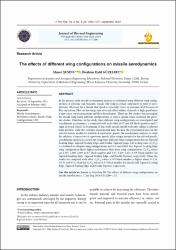| dc.contributor.author | Şumnu, Ahmet | |
| dc.contributor.author | Güzelbey, İbrahim Halil | |
| dc.date.accessioned | 2024-01-12T09:56:10Z | |
| dc.date.available | 2024-01-12T09:56:10Z | |
| dc.date.issued | 2023 | en_US |
| dc.identifier.citation | Şumnu, A., Güzelbey, İ.H. (2023). The effects of different wing configurations on missile aerodynamics. Journal of Thermal Engineering, 9 (5), pp. 1260-1271.
https://doi.org/10.18186/thermal.1377200 | en_US |
| dc.identifier.issn | 2148-7847 | |
| dc.identifier.uri | https://doi.org/10.18186/thermal.1377200 | |
| dc.identifier.uri | https://dergipark.org.tr/tr/pub/thermal/issue/80447/1377200 | |
| dc.identifier.uri | https://hdl.handle.net/20.500.12508/2983 | |
| dc.description.abstract | In the present study, missile aerodynamic analysis is performed using different wing configurations at subsonic and transonic speeds. The wing is critical component in point of aerodynamic efficiency for a missile that speed is especially closer to transonic level because of flow separation. Flow on the wings may adversely effect tailfins of missile at high speed since it may cause vortex generation and flow disturbances. There are few studies that investigate the missile wing using different configurations at critical speeds when examined the previous studies. Therefore, in this study, three different wing configurations are investigated and aerodynamic performance is compared with each other at 0.7 and 0.9 Mach numbers and 5° angle of attack (AoA). In beginning of this study, missile model with only tailfins is selected from previous study that contains experimental data. Because the experimental data for the selected missile model are available at supersonic speeds, the aerodynamic analysis to verify the solutions is carried out at supersonic speeds. After wing is mounted to the selected missile, aerodynamic analysis is carried out using three different wing configurations that are Tapered Leading Edge, Tapered Trailing Edge, and Double Tapered wings. Lift to drag ratio (CL/CD) is calculated to compare wing configurations and it is concluded that Tapered Leading Edge wing configuration shows higher performance then other wing configurations. CL/CD values are 2.327, 2.306, 2.303 at 0.7 Mach number and 2.45, 2.429, 2.423 at 0.9 Mach number for Tapered Leading Edge, Tapered Trailing Edge, and Double Tapered, respectively. When the results are compared each other, CL/CD values at 0.9 Mach number is higher about % 5.28, %5.33 and %5.21 than the CL/CD values at 0.7 Mach number for missile with Tapered Leading Edge, Tapered Trailing Edge, and Double Tapered, respectively. | en_US |
| dc.language.iso | tur | en_US |
| dc.publisher | Yildiz Technical University | en_US |
| dc.relation.isversionof | 10.18186/thermal.1377200 | en_US |
| dc.rights | info:eu-repo/semantics/openAccess | en_US |
| dc.subject | CFD | en_US |
| dc.subject | Missile aerodynamics | en_US |
| dc.subject | Missile wing configuration | en_US |
| dc.subject | Turbulence model | en_US |
| dc.subject.classification | Canard | |
| dc.subject.classification | Projectiles | |
| dc.subject.classification | Missiles | |
| dc.subject.classification | Electrical Engineering, Electronics & Computer Science
- Automation & Control Systems
- Guidance Law | |
| dc.subject.other | Shape optimization | |
| dc.subject.other | Projectile | |
| dc.title | The effects of different wing configurations on missile aerodynamics | en_US |
| dc.type | article | en_US |
| dc.relation.journal | Journal of Thermal Engineering | en_US |
| dc.contributor.department | Havacılık ve Uzay Bilimleri Fakültesi -- Havacılık ve Uzay Mühendisliği Bölümü | en_US |
| dc.identifier.volume | 9 | en_US |
| dc.identifier.issue | 5 | en_US |
| dc.identifier.startpage | 1260 | en_US |
| dc.identifier.endpage | 1271 | en_US |
| dc.relation.publicationcategory | Makale - Uluslararası Hakemli Dergi - Kurum Öğretim Elemanı | en_US |
| dc.contributor.isteauthor | Şumnu, Ahmet | |
| dc.relation.index | Web of Science - Scopus | en_US |
| dc.relation.index | Web of Science Core Collection - Emerging Sources Citation Index | |
















